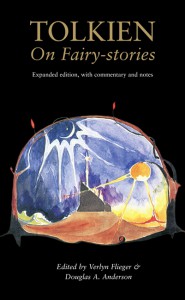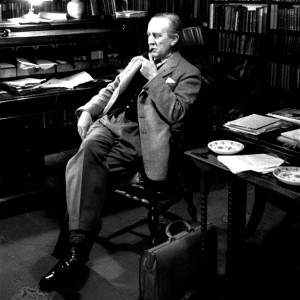 In our latest Library piece, TORn feature writer Tedoras discusses 10 key excerpts from J.R.R. Tolkien’s famous lecture On Fairy Stories.
In our latest Library piece, TORn feature writer Tedoras discusses 10 key excerpts from J.R.R. Tolkien’s famous lecture On Fairy Stories.
In case you’ve never read it, On Fairy Stories (which Tolkien first delivered as a lecture in 1939) examines the fairy-story as a literary form, and explains Tolkien’s philosophy of what fantasy is, and how it ought to work. As Verlyn Flieger and Douglas A. Anderson write in their introduction to the expanded 2008 reprint, On Fairy Stories is “[Tolkien’s] most explicit analysis of his own art”.
The virtues of fairy-stories
By Tedoras
Professor Tolkien—as he was known then—was a very busy man in 1938. Not only was he beginning to develop what would become The Lord of the Rings, but he also delivered at this time one of his most famous lectures, titled “On Fairy-stories.”
The original lecture was given as an Andrew Lang lecture at the University of St. Andrews; later, in 1947, it would be enlarged and published in Essays presented to Charles Williams by Oxford University Press. Today, “On Fairy-stories” can be found most readily in Tree and Leaf (or The Tolkien Reader, which contains the former).
This fine piece of scholarship provides a complete examination of fairy-stories, their origins, virtues, and historical context. In many ways, however, it is more concerned with the nature of Faërie itself, especially from the perspective of the sub-creator (this notion first appearing in the lecture) and the reader.
The text offers much to fans of The Hobbit and The Lord of the Rings, though few ever chance to stumble upon it. Below, I highlight some passages exemplary of the prolific wisdom and scholarship on display in this work, with the hope that it may lead some Tolkienites to discover (or rediscover) this wonderful and insightful (not to mention thoroughly amusing) read.
Passage #1
Most good “fairy-stories” are about the adventures of men in the Perilous Realm or upon its shadowy marches. Naturally so; for if elves are true, and really exist independently of our tales about them, then this also is certainly true: elves are not primarily concerned with us, nor we with them. (38)
Tolkien, true to his own words here, provides a similar setup in both The Hobbit and The Lord of the Rings: one in which someone familiar and relatable is thrown into something wholly unknown. This hallmark of the successful fairy-story highlights Tolkien’s own artistic ability; for certainly hobbits are not men, but he is able to paint such a vivid, lifelike portrait of those creatures that even readers—that is, those outside the sub-creator’s mind—can begin to understand them.
It is also remarkable that we should find here what is largely taken for granted in Middle-earth: the nature of elves and their relationship to us.
Passage #2
Faërie cannot be caught in a net of words; for it is one of its qualities to be indescribable, though not imperceptible. It has many ingredients, but analysis will not necessarily discover the secret of the whole. (39)
As Tolkien fans, and some of the most “obsessed” (if that is the right word) fans in general, the question is often put to us why: why do you love these works so much? It has always been difficult for me to answer this question—for how can I describe thousands of pages of magic in a few sentences?
It seems the Professor himself was aware of this quality of fairy-stories, one that is wrapped up in wonder and mystery and desire; and a quality that can never been fully understood until internalized through immersing oneself in the text imagined for just such a purpose. This point on analysis in the last sentence will also be important later.
Passage #3
In Dasent’s words I would say: “We must be satisfied with the soup that is set before us, and not desire to see the bones of the ox out of which it has been boiled…” By “the soup” I mean the story as it is served up by its author or teller, and by “the bones” its sources or material—even when (by rare luck) those can be with certainty discovered. But I do not, of course, forbid criticism of the soup as soup. (47)
 Who knew so much rarefied academic talk on the origins of contemporary literature could be boiled down (forgive the pun) to a mere conversation about soup? Interestingly, this snippet fits oddly well into an argument Tolkien fans and academics alike know too well: that of allegory versus application. Here, the Professor himself proclaims his preference for looking at a work as itself, not the sum of its inspirations or sources.
Who knew so much rarefied academic talk on the origins of contemporary literature could be boiled down (forgive the pun) to a mere conversation about soup? Interestingly, this snippet fits oddly well into an argument Tolkien fans and academics alike know too well: that of allegory versus application. Here, the Professor himself proclaims his preference for looking at a work as itself, not the sum of its inspirations or sources.
He goes on to call the question of origins the “least important…for my purpose;” an undoubtedly resounding disregard. And throughout the lecture, he takes up this mantle again; it is almost an obsession of his to fight off contemporary regard for the veritable “bones” of a work—but it is quite interesting how this fits into the context of Tolkien’s own works, which may be some of the most complex and convoluted “soups,” in terms of their “bones,” that there are.


